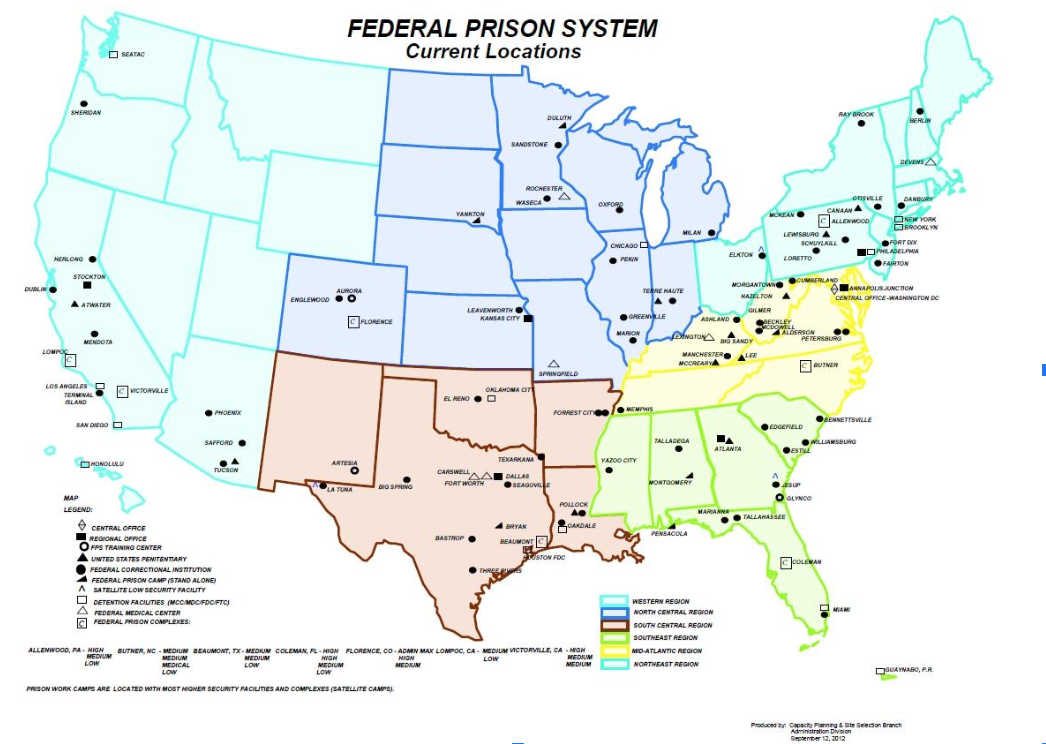7.9. Types of Prisons
David Carter and Kate McLean
Prisons in the United States can be categorized by jurisdiction, and the by intensity of their supervision. By jurisdiction, we are referring to who manages the prisons. A prison warden is generally considered the managerial face of the institution. However, a prison warden and the prison itself is usually within a much larger organizational structure, typically defined at the state level. There are a few jurisdictions at other levels that manage or operate prisons. This includes the federal government, which runs its own prison system (Bureau of Prisons), but also jurisdictions below or different from the state level, such as major cities like New York, Chicago, Philadelphia, and Washington D.C. Puerto Rico also has a prison, as does the U.S. territory of the Virgin Islands.
State Prisons
Typically, the organizational structure that manages state prisons is called the “Department of Corrections,” and is run by a Director or Secretary, who is usually appointed by the state governor. For example, in Pennsylvania, we have the Pennsylvania Department of Corrections, with George Little as the current head (Secretary) of this organization (2021-present). The Pennsylvania Department of Corrections currently overseas 23 State Correctional Institutions (or SCIs). While Eastern State Penitentiary is no longer in operation, the oldest working SCI – Huntingdon – opened in 1889, and followed the model of the Elmira Reformatory in New York. More information about the PDOC’s SCIs can be found here.
Federal Prisons
The Federal Bureau of Prisons (BOP) was established in the early 1930s as a result of the need to house an increasing number of individuals convicted of federal crimes. There were already some federal prisons in place prior to this time, but it was not until 1930 that the U.S. Congress passed legislation to create the BOP, housing it under the justice department. Sanford Bates became the first Director of the Federal Bureau of Prisons, based on his long-standing work as an organizer and leader at Elmira Reformatory in New York. As more federal legislation was passed, the need for more prisons became apparent.
Today, the BOP has 109 prisons, along with numerous additional facilities (camps) adjoining at these locations. There are also military prisons, alternative facilities, reentry centers, and training centers that are managed by the BOP. The federal prisons are separated into six region: the Mid-Atlantic Region, the North Central Region, the Northeast Region, the Southeast Region, the South Central Region, and the Western Region.
Within these regions are regional directors, which is similar to state-level directors of departments of corrections. Below is a detailed map of the regions of the Federal Bureau of Prisons. As is depicted, there are several different types of facilities within each region. A central office is also designated for each of the six regions. Notice the concentration of federal prisons in not only Pennsylvania, but our more rural neighbors to the south – what do you think accounts for prison-building in these places? (Curious? More here.)
FBOP Regional Map

Private Prisons
The privatization of certain goods and services offered in prison has long been a staple of state departments of corrections, as it allows these organizations to subcontract specific tasks within their prisons. This includes services like food and transportation services, medical, dental, and mental health services, education services, even laundry services. Moreover, the sale of prison-made goods for profit – and the sale of inmates’ labor to private corporations – goes back to the 19th century. Yet the first attempts to privatize an entire prison institution date back to the 1980s, when the politicization of crime led to rising arrests – and insufficient prison beds.
The term “private prisons” refers to institutions built and managed by private corporations, for a profit. Given that the rest of the criminal justice process – policing and the courts – are not privatized (at least not yet), private prisons must contract with states or the federal government, in order to receive and be paid for their housing of prisoners. In order to win contracts, private prison corporations have typically promised lower costs (for the state), with similar or better prisoner outcomes; however, it must be mentioned that private prisons make their money by spending even less than they are paid by the state, per inmate. The Corrections Corporation of America won the first U.S. contract for a private prison, opening their first institution in the 1984. Today, CoreCivic (formerly Corrections Corporation of America) runs approximately 128 facilities in the United States. [1] The GEO Group, the other primary private prison company in the United States, runs 136 correctional, detention, or reentry facilities. [2] Today, just over half of states incarcerates some prisoners within private institutions, including Pennsylvania. See the chart below to see where PA falls in the percentages of prisoners housed in private facilities. <footnote> Data from the Sentencing Project </footnote>
Much debate surrounds the use of private prisons, which house roughly 8% of all prisoners in the United States. Critics note the lack of transparency in private institutions’ reporting processes, compared to “normal” public prisons. Still, others tackle a bigger moral issue – punishment for profit. While taxpayers ultimately pay for the punishment of all individuals, either at the State or Federal level, shareholders and administrators of the companies are making money by punishing people, under the guise of capitalism.

